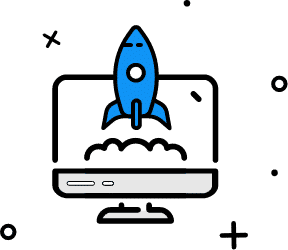Online entrepreneurs have big dreams and plans for their business.
You want to grow your income, impact, and influence with your amazing products and services. But how do you turn those dreams and plans into reality?
If you're like most entrepreneurs, you might struggle with staying focused and productive in your business. You might get distracted by shiny objects, overwhelmed by too many tasks, or frustrated by incomplete projects.
You might set yearly or quarterly goals, but find it hard to stick to them and see results. You might start many projects, but never finish them. You might feel like you're always busy, but not making any progress.
Does this sound familiar?
If so, don't worry. You're not alone. And there's a simple solution that can help you overcome these challenges and achieve your business goals faster and easier.
It's called the 6-week cycle strategy.
This strategy is based on the idea of working on one major project at a time, for a period of 6 weeks, followed by a 2-week cooldown period.
This way, you can focus on the most important and impactful project for your business, without getting sidetracked by other ideas or tasks. You can also plan and execute your project more effectively, without feeling rushed or stressed. And you can celebrate your wins and prepare for your next project during the cooldown period.
Sounds awesome, right?
But how do you implement this strategy in your business? And what kind of results can you expect from it?
In this blog post, I'm going to show you exactly how to use 6-week cycles in your business, whether you're a freelancer or a course creator. I'm also going to share some examples and tips from my own experience and from other successful entrepreneurs who use this strategy.
By the end of this post, you'll have a clear and simple plan to boost your productivity and achieve your business goals faster with 6-week cycles.
Ready? Let's dive in!
Step 1: Choose Your Project
The first step is to choose the project that you want to work on for the next 6 weeks.
This project should be something that will make a big difference in your business, such as launching a new product, creating a new lead magnet, setting up a new system, or revamping your website.
It should also be something that you can realistically complete in 6 weeks, without compromising on quality or scope. If your project is too big or complex, you might want to break it down into smaller sub-projects that you can tackle one at a time.
To help you choose your project, you can use a tool like ClickUp to create an Ideas Board where you can dump all your ideas for your business. Then you can prioritize and select the one that aligns best with your current business goals and vision.
For example, if your goal is to grow your email list, you might choose to create a new lead magnet as your project. If your goal is to increase your revenue, you might choose to launch a new product or service as your project.
Once you've chosen your project, write it down and commit to it. Don't let yourself get distracted by other ideas or tasks until you finish this project.
Step 2: Break Down Your Project
The next step is to break down your project into smaller tasks that you need to do to complete it.
These tasks should be specific, measurable, achievable, relevant, and time-bound (SMART). They should also be ordered logically and sequentially, so that you know what to do next at any given time.
To help you break down your project, you can use a tool like ClickUp to create a Project Board where you can list all your tasks and subtasks. Then you can assign dates and deadlines for each task, so that you know when to start and finish them.
For example, if your project is to create a new lead magnet, some of the tasks might be:
- Researching your target audience's pain points and desires
- Choosing a topic and format for your lead magnet
- Writing the content for your lead magnet
- Designing the graphics for your lead magnet
- Creating a landing page for your lead magnet
- Setting up an email sequence for your lead magnet
- Promoting your lead magnet on social media and other channels
Each of these tasks might have subtasks that need to be done as well. For instance, writing the content for your lead magnet might involve:
- Outlining the main points and benefits of your lead magnet
- Writing the headline and introduction of your lead magnet
- Writing the body and conclusion of your lead magnet
- Editing and proofreading your lead magnet
By breaking down your project into smaller tasks, you can make it more manageable and achievable. You can also track your progress and stay on track with your deadlines.
Step 3: Work on Your Project
The third step is to work on your project for the next 6 weeks, following your plan and schedule.
This is where you need to focus and take action on your tasks, without getting sidetracked by other ideas or tasks. You also need to be flexible and adaptable, in case you encounter any challenges or changes along the way.
To help you work on your project, you can use a tool like ClickUp to create a Calendar View where you can see all your tasks and deadlines for each week. Then you can plan your daily and weekly schedule accordingly, and mark off your tasks as you complete them.
For example, if your project is to create a new lead magnet, you might allocate 2 weeks for researching and writing the content, 1 week for designing the graphics, 1 week for creating the landing page and email sequence, and 2 weeks for promoting the lead magnet.
By working on your project for 6 weeks, you can give it your full attention and effort, without feeling rushed or stressed. You can also see results faster and easier, without waiting for months or years.
Step 4: Cool Down and Celebrate
The fourth step is to cool down and celebrate after you finish your project.
This is where you take a break from working on projects, and use the remaining 2 weeks of the cycle to wrap up any loose ends, reflect on your achievements, and prepare for your next project.
To help you cool down and celebrate, you can use a tool like ClickUp to create a Feedback Board where you can collect feedback from your team, clients, or customers on your project. Then you can analyze the feedback and identify what went well and what can be improved.
You can also use this time to reward yourself and your team for completing the project. You can celebrate by taking a vacation, buying something nice, or doing something fun. You can also share your wins and results with your audience and followers, and thank them for their support.
By cooling down and celebrating after finishing your project, you can recharge your energy and motivation, and appreciate your hard work and success. You can also learn from your experience and improve your skills and processes for future projects.
Step 5: Repeat
The fifth step is to repeat the cycle with a new project.
This is where you choose another project from your Ideas Board that will help you achieve your next business goal. Then you follow the same steps as before: break it down, work on it, cool down, and celebrate.
By repeating the cycle with a new project, you can keep growing and improving your business, without getting stuck or overwhelmed. You can also keep creating value and impact for your audience and customers, without getting bored or burned out.
How to Use 6-Week Cycles in Your Business: Examples and Tips
Now that you know how to use 6-week cycles in your business, let me share some examples and tips from my own experience and from other successful entrepreneurs who use this strategy.
As a freelancer, I use 6-week cycles to work on projects that will help me grow my own business, such as setting up my CRM system, creating my website, or launching my podcast. I also use 6-week cycles to work on projects for my clients, such as designing their logos, creating their lead magnets, or building their sales funnels.
As a course creator, I use 6-week cycles to work on projects that will help me grow my online courses or memberships, such as creating new content, updating existing content, or hosting live workshops. I also use 6-week cycles to work on projects that will help me grow my audience or revenue, such as launching a new course or membership, running a promotion or giveaway, or partnering with other influencers.
Tips that I've learned from using 6-week cycles in my business:
- Start small and simple. Don't try to tackle too many or too big projects at once. Choose one project that will make the most impact in your business right now.
- Be realistic and flexible. Don't expect to finish everything perfectly or exactly as planned. Be prepared to adjust or pivot if needed.
- Track and measure your progress. Don't just rely on your feelings or opinions. Use data and feedback to evaluate how well you're doing.
- Communicate and collaborate. Don't work in isolation or silence. Share your goals and plans with your team, clients, or customers. Ask for help or support if needed.
- Have fun and enjoy the process. Don't take yourself or your project too seriously. Celebrate your wins and learn from your mistakes.
Using 6-week cycles in your business is a simple but powerful way to boost your productivity and achieve your goals faster. By working on one major project at a time, for a period of 6 weeks, followed by a 2-week cooldown period, you can:
- Focus on the most important and impactful project for your business, without getting sidetracked by other ideas or tasks
- Plan and execute your project more effectively, without feeling rushed or stressed
- See results faster and easier, without waiting for months or years
- Recharge your energy and motivation, and appreciate your hard work and success
- Learn from your experience and improve your skills and processes for future projects
Using 6-week cycles in your business is a simple but powerful way to boost your productivity and achieve your goals faster.
Disclaimer: Some of the links in this post are affiliate links, which means I may earn a small commission if you click on them and make a purchase. However, I only recommend products that I personally use and love every day. Thank you for your support! 😊




